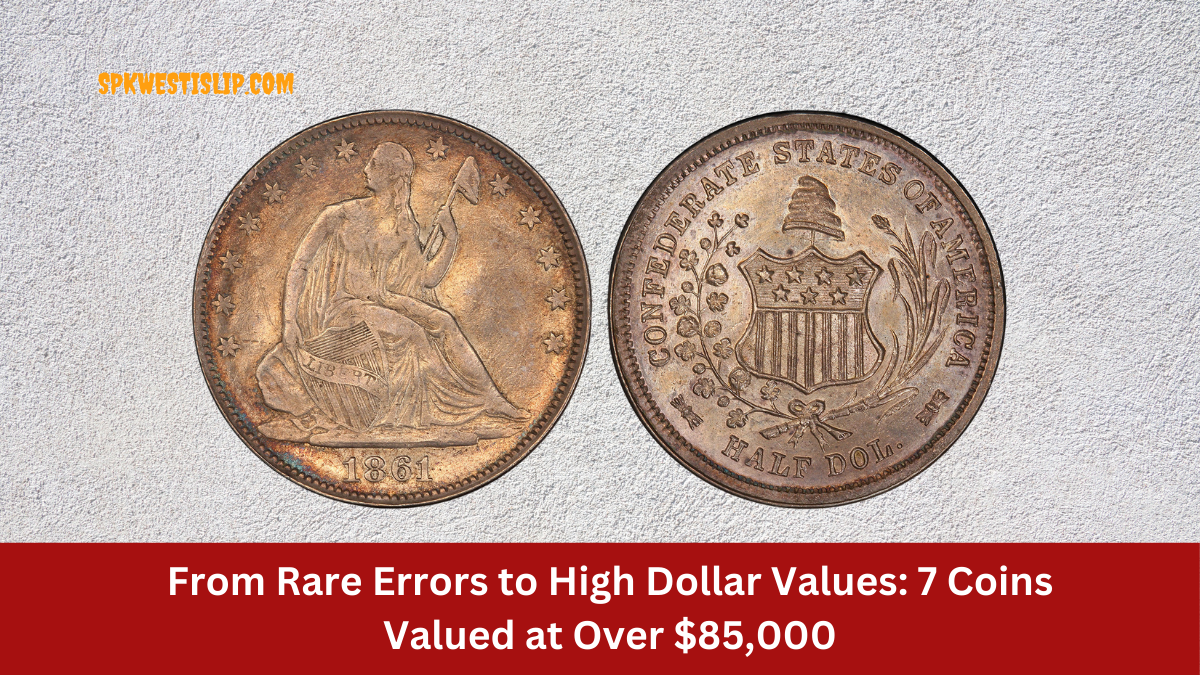Rare coins offer collectors a window into history and provide a unique opportunity for substantial financial gain. Coins with distinct errors, limited mintage, or rich historical connections often command impressive prices in the collector’s market.
This guide dives into seven rare US coins valued at over $85,000, showcasing what makes each one so desirable and how these coins have gained legendary status among numismatists. Here’s a look at these valuable treasures.
Coins Valued at Over $85,000
1804 Silver Dollar
The 1804 Silver Dollar is a legendary coin known as the “King of American Coins.” Its rarity stems from a limited production and historical significance, initially intended for diplomatic gifts.
With only 15 known specimens in existence, the 1804 Silver Dollar has fetched prices exceeding a million dollars at auction, making it highly prized among collectors.
1933 Saint-Gaudens Double Eagle
The 1933 Saint-Gaudens Double Eagle represents a rare piece of American history, with production stopped due to the US exit from the gold standard. Nearly all were melted down, but a few survived and are now worth millions. This coin is a highlight in the numismatic world, not only for its value but also for its intriguing history.
1913 Liberty Head Nickel
With only five specimens known, the 1913 Liberty Head Nickel is among the most coveted US coins. Its unauthorized minting led to a limited number of coins, making it highly rare and valuable. These coins have been sold for well over $3 million, solidifying their status as one of the rarest and most valuable nickels.
1794 Flowing Hair Dollar
The 1794 Flowing Hair Dollar is considered the first silver dollar minted in the US. Its historical significance, combined with a limited number of surviving coins, has seen this coin reach astronomical auction prices. Many consider it the most valuable American coin ever minted due to its rarity and historical place in US currency history.
1943 Copper Penny
Most pennies minted in 1943 were made from steel due to wartime copper shortages, making the few copper versions extremely rare. With only a handful known to exist, this unique error coin is highly prized by collectors and has reached impressive values at auction, far exceeding its one-cent face value.
1861 Confederate Half Dollar
The 1861 Confederate Half Dollar represents a unique part of American history, minted during the early days of the Civil War. Only a few of these coins were ever produced, each symbolizing a tumultuous period in US history.
Its rarity and historical significance have made it a prized possession for numismatists, with values exceeding hundreds of thousands of dollars.
1885 Trade Dollar
Minted for use in trade with Asia, the 1885 Trade Dollar is another rarity with only a few known surviving specimens. The limited production and its distinctive design have made it highly sought after in the collector’s market, with values reaching impressive heights due to its scarcity and unique background.
| Coin Name | Year | Mintage (Approx.) | Estimated Value | Notable Feature |
|---|---|---|---|---|
| 1804 Silver Dollar | 1804 | 15 | Over $1 million | Diplomatic gift intentions |
| 1933 Saint-Gaudens | 1933 | Less than 20 | Over $1 million | Stopped production post-gold |
| 1913 Liberty Head Nickel | 1913 | 5 | Over $3 million | Unauthorized minting |
| 1794 Flowing Hair Dollar | 1794 | Few hundred | Over $10 million | First US silver dollar |
| 1943 Copper Penny | 1943 | Estimated 40 | Over $100,000 | Unique minting error |
| 1861 Confederate Half | 1861 | Few | Over $500,000 | Confederate minting |
| 1885 Trade Dollar | 1885 | 5 | Over $500,000 | Limited trade use |
While each of these coins holds its own unique story, they all share a common attribute: rarity. Collectors around the world continue to pursue these coins, recognizing both their historical importance and their high-dollar value in the marketplace.
FAQs
1. What makes a coin valuable?
A coin’s value is influenced by factors such as rarity, historical significance, condition, and demand among collectors. Rare coins with errors, limited mintage, or significant historical context often fetch high prices.
2. How can I determine if my coin is rare?
A good way to start is by consulting a reputable coin grading service or numismatist. They can help you evaluate the coin’s rarity and potential value based on its characteristics and historical context.
3. Why are some coins with errors so valuable?
Errors in coin production are relatively rare, and collectors often find them intriguing, especially if the error was unintended and resulted in a limited number of coins. This rarity makes them more desirable and valuable.
4. Are rare coins a good investment?
Rare coins can appreciate over time, particularly those with historical significance or unique features. However, the coin market can be volatile, and it’s essential to research and seek expert advice before investing.
5. How do I safely store valuable coins?
Coins should be stored in a cool, dry place, ideally in protective cases or containers that prevent exposure to moisture and air. Specialized coin holders and storage solutions can also help maintain their condition.
